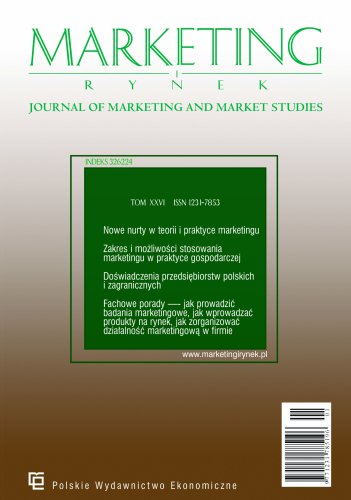Subcultures, online communities versus communities around the brand — definitions
The term community is well established in the terminology used by marketing environments. The aim of the study is to present the essence of the terms community around the brand, subculture and community on the Internet and to indicate the consequences for the world of marketing resulting from the differences between them.
References
Bibliografia/References
Bagozzi, R. i Dholakia, U. M. (2002). Intentional social action in virtual communities. Journal of Interactive Marketing, 16(2). https://doi.org/10.1002/dir.10006
Bakeberg, B. (2016). Online brand communities: Value creating capabilities of brand communities on Facebook. Hamburg: Anchor Academic Publishing.
Brogi, S. (2014). Online Brand Communities: A Literature Review. Social and Behavioral Sciences, 109.
Brown, R. (2006). Procesy grupowe. Dynamika wewnątrzgrupowa i międzygrupowa. Gdańsk: GWP.
de Burgh-Woodman, H. i Brace-Govan, J. (2007). We do not live to buy. Why subcultures are different from brand communities and the meaning for mar- keting discourse? International Journal of Sociology and Social Policy, 27(5/6). https://doi.org/10.1108/01443330710757230
Davis, R., Piven, I. i Breazeale, M. (2014). Conceptualizing the brand in social media community: The five sources model. Journal od Retailing and Consumer Services, 21(4). https://doi.org/10.1016/j. jretconser.2014.03.006
Dubois, T. (2011). Westerhausen, U. Brand loyalty creation within online brand communities. Copenhagen Business School.
Durkheim, E. (1964). The Division of Labour in Society. New York, London: Free Press, Collier Macmillan.
Grębosz-Krawczyk, M. i Siuda, D. (2017). Typy uczestników wirtualnych społeczności marek. Studia Ekonomiczne. Zeszyty Naukowe Uniwersytetu Ekonomicznego w Katowicach, (328). https://doi.org/10.15611/pn.2018.525.22
Habibi, M. R., Laroche, M. i Richard, M. O. (2014). Brand communities based in social media: How unique are they? Evidence from two exemplary brand communities. International Journal of Information Management, 34. https://doi.org/10.1016/j.ijinfomgt.2013.11.010
Kang, I. Lee, K., Lee, S. i Choi, J. (2007). Investigation of online community voluntary behavior using cognitive map. Computers in Human Behavior, 23(1). https://doi.org/10.1016/j.chb. 2004.03.039
Kaplan, A. M. i Haenlein, M. (2010). Users of the world, unite! The challenges andopportunities of Social Media. Business Horizons, 53(1). https://doi.org/10.1016/j.bushor.2009.09.003
Kietzmann, J. H., Hermkens, K., McCarthy, I. P. i Silvestre, B. S. (2011). Social media? Get serious! Understanding the functional building blocks of so- cial media. Business Horizons, 54(3). https://doi.org/10.1016/j.bushor. 2011.01.005
Kozinets, R. V. (2002). The field behind the screen: using netnography for marketing research in online communities. Journal of Marketing Research, 39(1). https://doi.org/10.1509/jmkr.39.1.61.18935
Mangold, W. G. i Faulds, D. J. (2009). Social media: The new hybrid element of the promotion mix. Business Horizons, 52(4). https://doi.org/10.1016/j. bushor.2009.03.002
Mazurek, G. (2008). Blogi i wirtualne społeczności — wykorzystanie w marketingu. Kraków: Oficyna a Wolters Kluwer business.
Muniz, A. M. i O’Guinn, T. C. (2001). Brand Community. Journal of Consumer Research, 27(4).
Muntinga, D. G., Moorman, M. i Smit, E. G. (2011). Introducing COBRAs. Exploring motivations for brand-related social media use. International Jour- nal of Advertising, 30(1). https://doi.org/10.2501/ija-30-1-013-046
Pawlak, H. i Nierebiński, R. (2011). Społeczność wirtualna jako społeczny kanał kreowania zawartości Internetu. Studia Informatica, 28.
Rehmani, M. i Khan, M. I. (2011). The Impact of E-Media on Customer Purchase Intention. International Journal of Advanced Computer Science and Ap- plications, 2(3).
Rheingold, H. (1993). Virtual Community: Homesteading on The Electronic Frontier. Cambridge: The MIT Press.
Schouten, J. W. i McAlexander, J. H. (1995). Subcultures of Consumption: An Ethnography of the New Bikers. The Journal of Consumer Research, 22(1). https://doi.org/10.1086/209434
Sicilia, M. i Palazón, M. (2008). Brand communities on the internet A case study of Coca-Cola’s Spanish virtual community. Corporate Communications. An International Journal, 13(3). https://doi.org/10.1108/13563280810893643
Simmons, G. (2008). Marketing to postmodern consumers: introducing the internet chameleon. European Journal of Marketing, 42(3/4). https://doi.org/10.1108/03090560810852940
Skorek, M. (2018). Społeczności internetowe wokół marki — korzyści konsumentów i menedżerów marki. Przedsiębiorczość i Zarządzanie, 19(5, cz. 2).
Skorek, M. (2019). Społeczność wokół marki. Geneza. Koncepcja. Badania. Warszawa: PWE.
Solomon, M. R. (2004). Consumer Behaviour: Buying, Behaving and Being. New Jersey: Pearson Prentice-Hall.
Szczepański, J. (1965). Elementarne pojęcia socjologii. Warszawa: PWN.
Sznajder, A. (2014). Technologie mobilne w marketingu, Warszawa: Wolters Kluwer.
Typaldos, C. (2012). Community standards. Pozyskano z http://www.fastcompany. com/magazine/38/ideazone.html
Van Herten, A. (2010). The role of superusers in a virtual brand community. The University of Guelph.
Voorveld, H. A. M., van Noort, G., Muntinga, D. G. i Bronner, F. (2018). Engagement with Social Media and Social Media Advertising: The Differentiating Role of Platform Type. Journal of Advertising, 47(1). https://doi.org/10.1080/00913367.2017.1405754
Wiktor, J. W. (2013). Komunikacja marketingowa. Warszawa: Wyd. Naukowe PWN.

